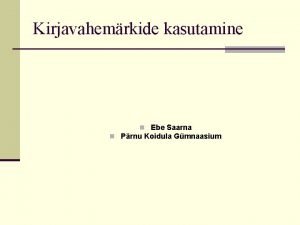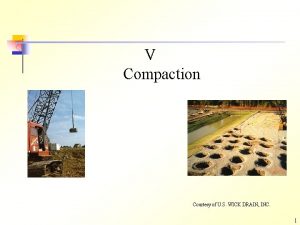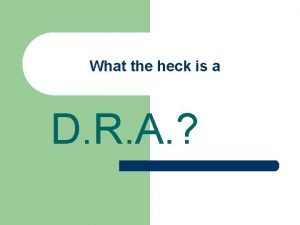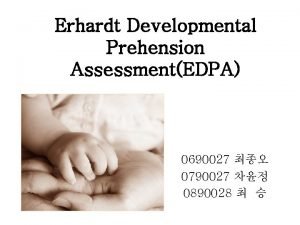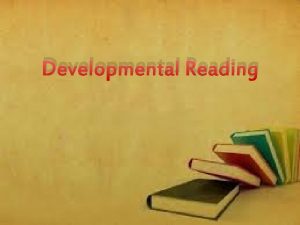DRA DEVELOPMENTAL READING ASSESSMENT De Ette Wick Victoria


















- Slides: 18

DRA DEVELOPMENTAL READING ASSESSMENT De. Ette Wick Victoria

Developed by: Joetta M. Beaver In collaboration with classroom teachers

What is DRA? Grades – Kindergarten through 8 th grade Standardized reading test used to assess a student’s reading performance and determine a student’s instructional level in reading. Administered individually to students by teachers Provides a method for assessing AND documenting development over time Allows teachers to observe, record, and evaluate changes in performance

Components Benchmark Assessment Books � Fiction and Nonfiction Texts Teacher Guide Assessment Forms Student Assessment Folders Organizer Box Blackline Masters Training DVD DRA Word Analysis

DRA Books

Teacher Observation Guides 1. 2. 3. 4. 5. 6. Section used to record scores for EACH section at the end of the assessment. Student responses are recorded; beginning with Level 28, students complete a Student Reading Survey Bold, italicized print is what you read or say aloud Levels 4 -16 students do a “picture walk” Oral reading is timed with starting with Level 14 Student’s miscues, including substitutions, omissions, insertions, repetitions, and self-

Teacher Observation Guides cont’d After student finishes reading, oral reading time is recorded 8. Words-per-minute range is based on oral reading time 9. All miscues that are NOT self corrected are counted and number is circled to determine percentage of accuracy 10. Assessment is stopped if student’s score falls in the shaded areas for either words-per-minute or accuracy 7. Reassess student with a lower level text

Teacher Observation Guides cont’d Levels 4 -24 students orally retell the story, Levels 28 -40 students write a story summary 12. Story overview is provided to record what students include in their retellings 13. Place checkmarks beside each questions or prompt to indicate how much support was given during the retelling No other prompts are permitted. 14. Response questions and prompts provide students with an opportunity to reveal connections made 11.

Teacher Observation Guides cont’d Reading behaviors that match student’s oral reading are recorded; specific miscue information is also recorded 16. Optional formula provides student’s exact reading rate 17. Instructions on how to complete the Continuum 15.

Steps for Administering Prepare for the Assessment Conduct the Assessment Conference Analyze Student Performance Plan and Group for Instruction

Preparing for the Assessment Check to see that you have the books and forms you need to conduct the assessments. Make copies of the assessment forms you plan to use Assemble assessment materials (stop watch) Review how to take a running record Read all assessment benchmark assessment books that you will be using. Prepare a place for the assessment conference

Conducting the Assessment Conference Step 1: Select a range of leveled texts Step 2: Have the student select a text. � Invite student to select a text that seems “just right” from the range of leveled texts provided Step 3: Record the student’s responses and behaviors in each of the following areas: Reading Engagement � Oral Reading Fluency � � Comprehension: Prediction � Introduction and Preview Take a Record of Oral Reading Oral Predictions (Levels 18 -38) Written (Level 40+) Comprehension: Retelling

Suggested Levels to Begin 1 st Grade • On grade level in K: 3 -4 • Below grade level in K: A-2 • Above grade level in K: 8 -14 2 nd Grade • On grade level in 1 st grade: 16 -18 • Below grade level in 1 st grade: 10 -14 • Above grade level in 1 st grade: 28 -34 3 rd Grade • On grade level in 2 nd grade: 28 -30 • Below grade level in 2 nd grade: 1824 • Above grade level in 2 nd grade: 3438

Sample DRA Test http: //www. youtube. com/watch? v=bjw. YVv 0 bx 2 s&feature=youtu. be

Analyze Student Performance Complete the teacher observation guide Complete the continuum page Complete the DRA 2 focus for instruction page

DRA Word Analysis If student’s Oral Reading Accuracy falls in the Emerging or Developing (Levels A-12) or Intervention or Instructional (Levels 14 -28) range of performance due to insufficient word analysis skills and strategies, conduct the DRA Word Analysis. Consists of 40 -word analysis tasks that assess a student’s level of control Divided into five strands: phonological awareness, metalanguage, letter/word recognition, phonics, and structural analysis

Word Analysis Examples

Conclusion/ Other Information DRA helps to determine both independent and instructional levels � 90 -94% range represents the student’s instructional level � 95 -100% range with fluency, accuracy, and comprehension represents the student’s independent level � Independent levels are generally one or two levels lower than instructional levels DRA helps to guide instruction DRA helps to identify specific problems a student is having DRA is not recommended as a monthly assessment – over-use can lead to students “learning the test”
 Koma kui ka ees
Koma kui ka ees Ent ette koma
Ent ette koma Ette email
Ette email La victoria privada
La victoria privada The witches of easter-wick in finland
The witches of easter-wick in finland Gary wick
Gary wick Relative compaction formula
Relative compaction formula Andywick
Andywick I spy creator
I spy creator Ear wick
Ear wick Dehiscence
Dehiscence Marc wick
Marc wick While reading activities
While reading activities What does dra stand for in reading
What does dra stand for in reading Edpa 평가지
Edpa 평가지 St. louis
St. louis Difference between silent reading and reading aloud
Difference between silent reading and reading aloud Intensive reading in communication skills
Intensive reading in communication skills Guided reading vs shared reading
Guided reading vs shared reading

